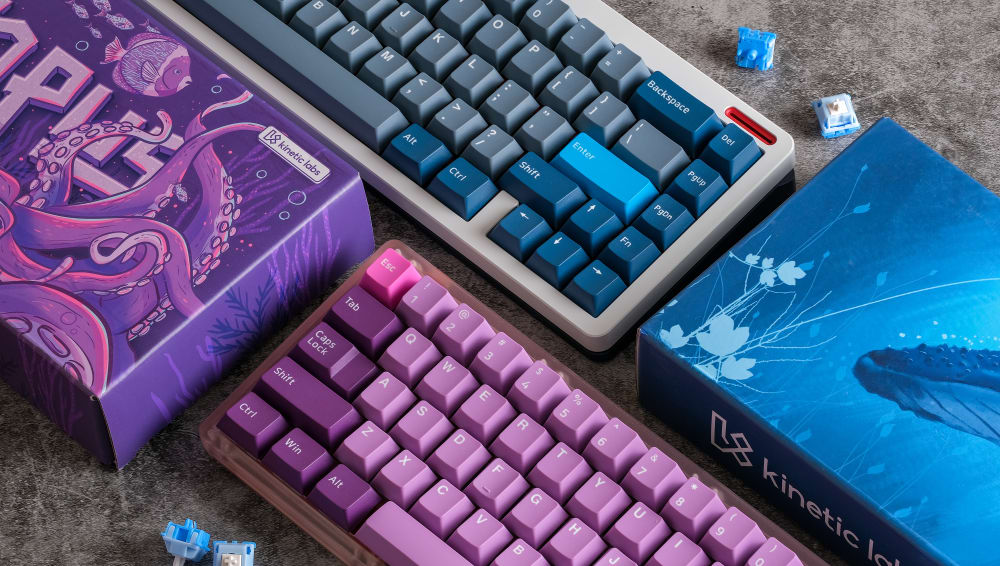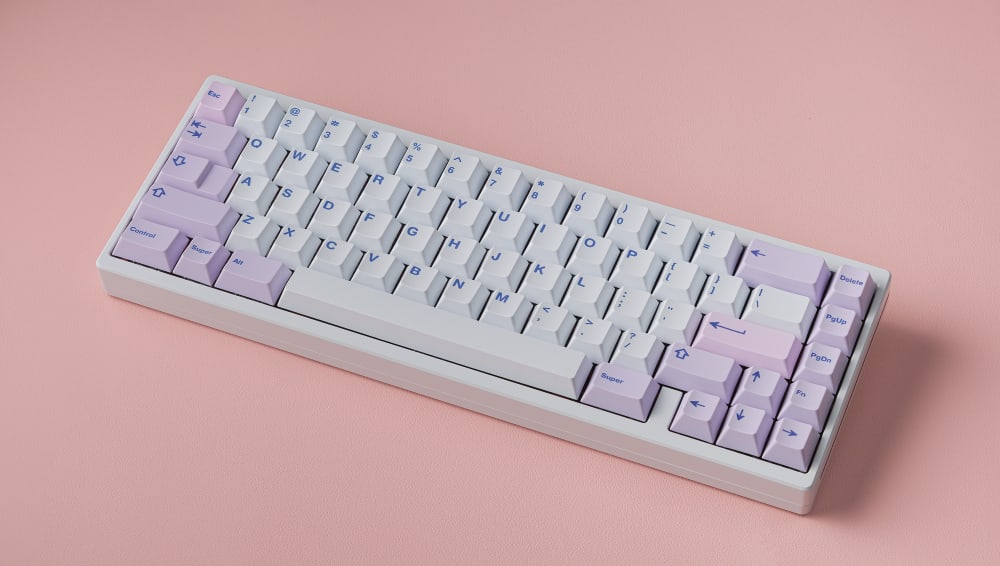Catherine L.
Aug 21, 2022
•5 minutes
ANSI vs ISO: Which Keyboard Layout is Best for You?
You may have heard of ISO and ANSI layouts, but which one is right for your next mechanical keyboard build? In this post I help you compare their pros and cons.


PolyCaps Whale & Octopus PBT Keycaps
Choosing a new keyboard seems so simple - until you get to all the nuances. In addition to the ergonomics, cost, and size, choosing between the ANSI and ISO layout of individual keycaps can make quite the difference in how functional your new hardware will be. Let's dig into the difference between these two layout types, and which of them makes the most sense for you.
What is an ANSI Keycaps Layout?
An ANSI keycaps layout follows the standards set by the American National Standards Institute and is typically defined by a wide rectangular Enter key sitting beneath the Backslash key. The left and right Shift keys are usually 2.25u and 2.75u, respectively, while both the left and right Alt keys have the same function. Depending on the layout, split-shift layouts may have smaller layouts on the left and right sides of the board as well.


ANSI Layout with Hippo PBT
Full-size ANSI keyboards have a total of 104 keys and are most common in the United States, Canada, Australia, the Netherlands, and many Asian and Middle Eastern countries. The layout does not allow for an extra character that some languages might require, like an ß in German.
What is an ISO Keycaps Layout?
An ISO keyboard layout follows the standards set by the International Organization for Standardization and most obviously differs from an ANSI layout by its upside-down L-shaped Enter key that sits directly underneath the Delete key. The right Alt key is replaced with an Alt Gr key that most languages use to create special characters, like umlauts (ö) in German.


PolyCaps Corn ISO Layout Enter Key
ISO keyboards typically have 105 keys and are most common in most European countries and South America. The backslash button lives to the bottom left of the enter key and the right-side shift key is larger than the left, allowing space for an extra character on the lower left of the layout.
ANSI vs. ISO: Pros and Cons
Both ANSI and ISO keyboards naturally include some advantages and disadvantages based on how the layout differs:
- The Enter key location: It's further away from the home row in the ISO layout, making one of the more frequently used keys on any layout more difficult to reach with your pinky.
- The Backslash key location: It's further away and in an unnatural spot, between functional/non-character keys in the ANSI layout. That's an especially important fact for coders.
- The Left Shift key location: Its 50% smaller size in the ISO layout takes the left Shift key about 1 inch further away from the pinky's natural position, which can result in ergonomic issues.
- The right Alt key function: The unique Alt Gr function on the ISO layout is essential for languages that require characters with diacritics, like accents over letters. It also adds the ability to include a third letter on each key, like a € symbol that requires pressing a more complex shortcut in ANSI layouts.
- The extra character: Languages that have more than the US-standard 26 letters in the alphabet can benefit from the extra space gained next to the left shift button.
Finally, keep in mind that both keycaps and tactile switches are more difficult for find for ISO keyboards than they are for ANSI keyboards. They still exist, of course, but most keycaps and tactile switches are optimized for ANSI keyboards.
Should I Get ISO or ANSI Keyboard?


ANSI Layout on PolyCaps Candy Shop
As you might expect from looking at the above pros and cons, there is no simple best choice between ISO and ANSI keyboards. Instead, it comes down to both preferences and desired functionality.
If ergonomics are your biggest concern, an ANSI keyboard offers more natural typing abilities. Frequent typing in different languages that require extra characters, or coding that requires more frequent use of the backslash key, may be reasons to choose an ISO keyboard instead.
Beyond that, your location is likely your biggest choice factor. You'll most easily find each keyboard options in the regions mentioned above; ANSI in the United States, Canada, Australia, and many asian countries, and ISO in Europe. And of course, a fully programmable keyboard can help ease many of the worries and confusion caused by keys in unexpected places.
Which is More Common: ANSI or ISO?
Around the globe, the ANSI keyboard is the most common option for home and professional use. That's especially true in the countries outlined above. the biggest exception in popularity is Europe, where most countries (except for the Netherlands) prefer the ISO layout.
Final Thoughts
The differences between ISO and ANSI keyboards is subtle, but they can make a big impact depending on how you plan to use it. Taking a close look at each alternative, and even taking both out for a "test drive", is an important part of making sure that you choose the best option for your needs and preferences.
Keep the potential equipment and add-ons you might want to use in the future, as well. For example, keycaps can be difficult to find for ISO keyboards, and tactile switches are also more uncommon for the more unique shapes like the upside-down l-shaped enter key.
We can help with that last piece. To learn more about our ear-soothing tactile switches, eye-popping keycaps, or jaw-dropping deskmats, get in touch with us. We're always happy to answer any questions! For more blog posts, guides, and content about mechanical keyboards, follow our blog.
Frequently Asked Questions
- Is Mac keyboard ISO or ANSI?
- Apple magic keyboards are typically ANSI, but also available as ISO layouts in European countries where that's the standard. For example, a magic keyboard on the German Apple Store has all the typical ISO features, from the upside-down L of the enter button to the shorter left Shift button.
- Is ANSI or ISO better for gaming?
- Most gamers prefer ANSI keyboards. The left Shift button is commonly used for commands like crouching in first-person shooters, and easier to press in its larger form. In addition, the broader availability of keycaps makes ANSI a good choice when modding out your keyboard.
- Is a US keyboard the same as UK?
- Both are QWERTY layouts, but the US keyboard differs from the UK because it follows ANSI standards while the UK version follows ISO standards. In addition, the # symbol is replaced by a £, the @ and quote are swapped, and the Backslash key is moved to the extra space next to the left Shift key that the ISO layout frees up.